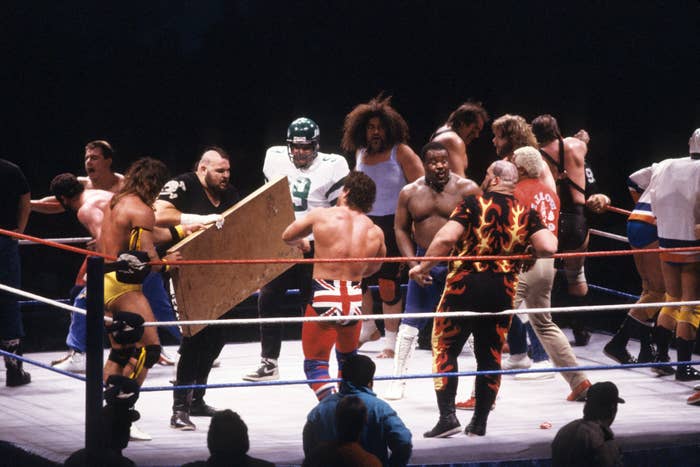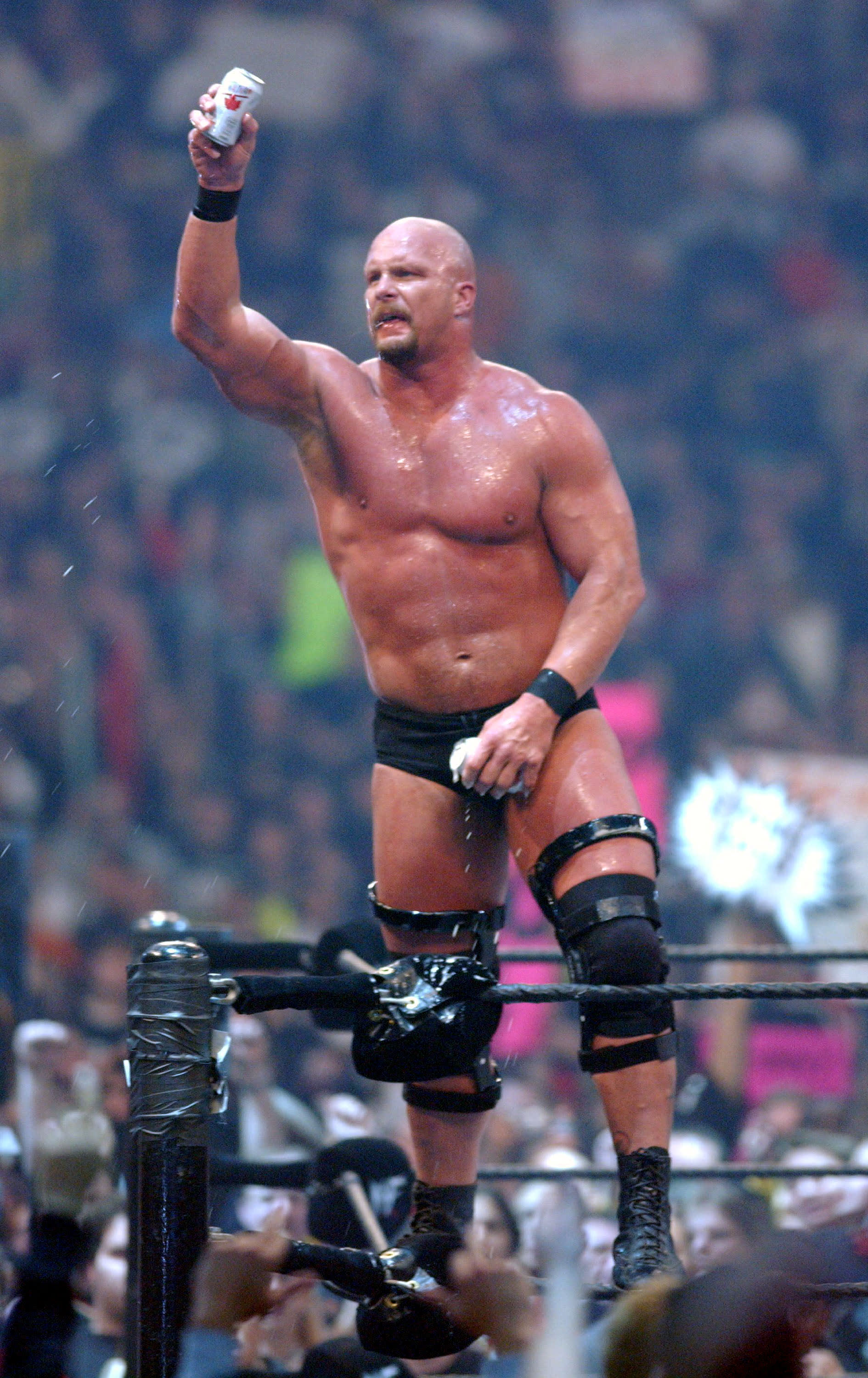
It’s January, which, for wrestling fans, means it’s the start of the most exciting time of the year. Sunday is the 30th Royal Rumble, the annual spectacle that features 30 superstars competing for a chance to main event against the WWE World Champion at WrestleMania in April. One of sports-entertainment’s longest-running traditions, this year’s installment also marks the 20th anniversary of the 1997 Royal Rumble, arguably the most historic installment, which its commemorating by emanating from San Antonio’s Alamodome.
The concept of a “battle royale” predates what we know today as professional wrestling by over three centuries. The earliest advertisements for multi-competitor every-man-for-himself donnybrook date back to the early 1700s. Presumably, what made them exciting is what makes events like the Royal Rumble such a spectacle today: a break from the norm of one-on-one competition to allow the fun of a chaotic melee where absolutely anything can happen, allowing one competitor to emerge victorious.
But the Royal Rumble is special. Originally envisioned in 1988 by WWF Hall of Famer and first Intercontinental Champion Pat Patterson, it began as a USA Network special. The original had 20 competitors draw a number with those selecting Nos. 1 and 2 starting the match. Every two minutes, one more competitor would enter, with the remaining man standing after each other competitor was eliminated by being thrown over the top rope being declare the winner.

It’s telling that, for as much as wrestling has changed over the past 30 years, the Rumble’s been enough of a constant favorite to remain largely unchanged. After it became a 30-man Rumble in 1989, the format has remained largely identical (save for one 40-man Rumble in 2011). Not even the other long-standing WWE events like the Survivor Series (whose signature elimination matches have been numerously tweaked and sometimes outright abandoned) and King of the Ring (which has gone from an annual pay-per-view to an occasional special event every few years) can boast being that strong and consistent of a formula. Just as WrestleMania is the larger-than-life celebrity-studded sports-entertainment spectacle, the Royal Rumble is the multi-man mayhem where true surprises can happen.
Perhaps the greatest Royal Rumble moment came in 1992 when Ric Flair emerged victorious. Due to a championship vacancy, he won the WWF World title less than a half-year in the company. It’s the type of storytelling drama that the Rumble was made for. The heavily hyped-Flair made his WWF pay-per-view debut, but drew the unlucky early entry No. 3. Despite this (and with much cheering from his advocate Bobby “The Brain” Heenan on commentary) Flair went a full hour, winning the title and outlasting Hulk Hogan, “Macho Man” Randy Savage, “Million Dollar Man” Ted DiBiase, Sgt. Slaughter, and “Rowdy” Roddy Piper. For one of the all time greats like Flair, his ’92 Rumble performance might be his magnum opus.
With the constant stream of characters interacting in front of audiences who may not otherwise have such a focus on them, it’s a night that’s both made stars and kick-started re-inventions.
For newer fans or lovers of the current WWE product, the Rumble allows just about the entire roster a chance to shine. With the constant stream of characters interacting in front of audiences who may not otherwise have such a focus on them, it’s a night that’s both made stars and kick-started re-inventions. For longtime fans, those 30 slots also press nostalgia buttons, allowing for stars of decades past who have not been seen on WWE television for quite some time to have one more go. For non-WWE fans who have somehow found themselves at a Rumble party, the match is a great point of accessibility. The occasional surprise non-WWE personality entrant, Drew Carey in 2001, sometimes steps into the ring.
This year’s return to the Alamodome is special because of what a major event that Rumble was 20 years ago. Headlined by hometown hero Shawn Michaels facing heated rival Sycho Sid for the WWF Championship, the event drew 60,477 fans, the largest non-WrestleMania crowd in the United States that the WWF had ever had. The industry was on the verge of its first real boom period since the 1980s Rock ’n’ Wrestling heyday, so the visual alone of that many people in one location to watch some squared circle action was a promising omen for what was to come.

The Royal Rumble match itself that year was among the most stacked. Perhaps most famous for being “Stone Cold” Steve Austin’s first Rumble win, a feat he accomplished by cheating and sneaking back in the ring to throw The Undertaker, Vader, and Bret “The Hitman” Hart over the top rope after being tossed out without the referees seeing, the other participants are of pretty major note. The last person legally eliminated was the second wrestler to portray the Diesel character, a short-lived gig. Later that year, he found legendary success re-debuting as The Undertaker’s brother Kane.
Also found in a different incarnation during the Rumble are Greenwich blueblood Hunter Hearst-Helmsley (for those wondering all this time what Triple H stood for), The Sultan (a masked middle-eastern character who would becoming significantly more appealing to fans exchanging the red leather facial-abomination for sunglasses and the camel clutch for the stinkface as Rikishi) and Jesse James (“Oh, you didn’t know” that ten months later he’d become The Road Dogg?). But probably the most important of these would be the Royal Rumble debut of Rocky Maivia, a smiling blue-chipper rookie the company heavily suggested could win the whole thing, which he wouldn’t do for another three years until he had fully transformed into The Rock.
There were plenty of present-day and past legends in the Rumble as well. Terry Funk, one of the most important figures in Texas wrestling history, just feels right making an appearance. As does the close proximity to the border and Mexican promotion AAA allowing Lucha legend Mil Mascaras to climb into the ring as well. Plus “Mankind” Mick Foley, Jake “The Snake” Roberts, Jerry “The King” Lawler, Ron “Farooq” Simmons, The British Bulldog, Owen Hart, high-flying innovator 2 Cold Scorpio (as Flash Funk), and Goldust. When two-thirds of the participants are current or future WWE Hall of Famers, you know you have a classic Rumble.
It’s precisely the variety, unpredictability and fun of the 1997 Rumble that makes the event such an absolute must-see each year. With the 2017 match already announced to have The Undertaker, Goldberg, Brock Lesnar, Chris Jericho and Randy Orton, in addition to the main event of John Cena meeting AJ Styles in a rematch of 2016’s match of the year, the 2017 Royal Rumble truly remains the event worth of sitting at the throne of the WWE’s calendar year.

